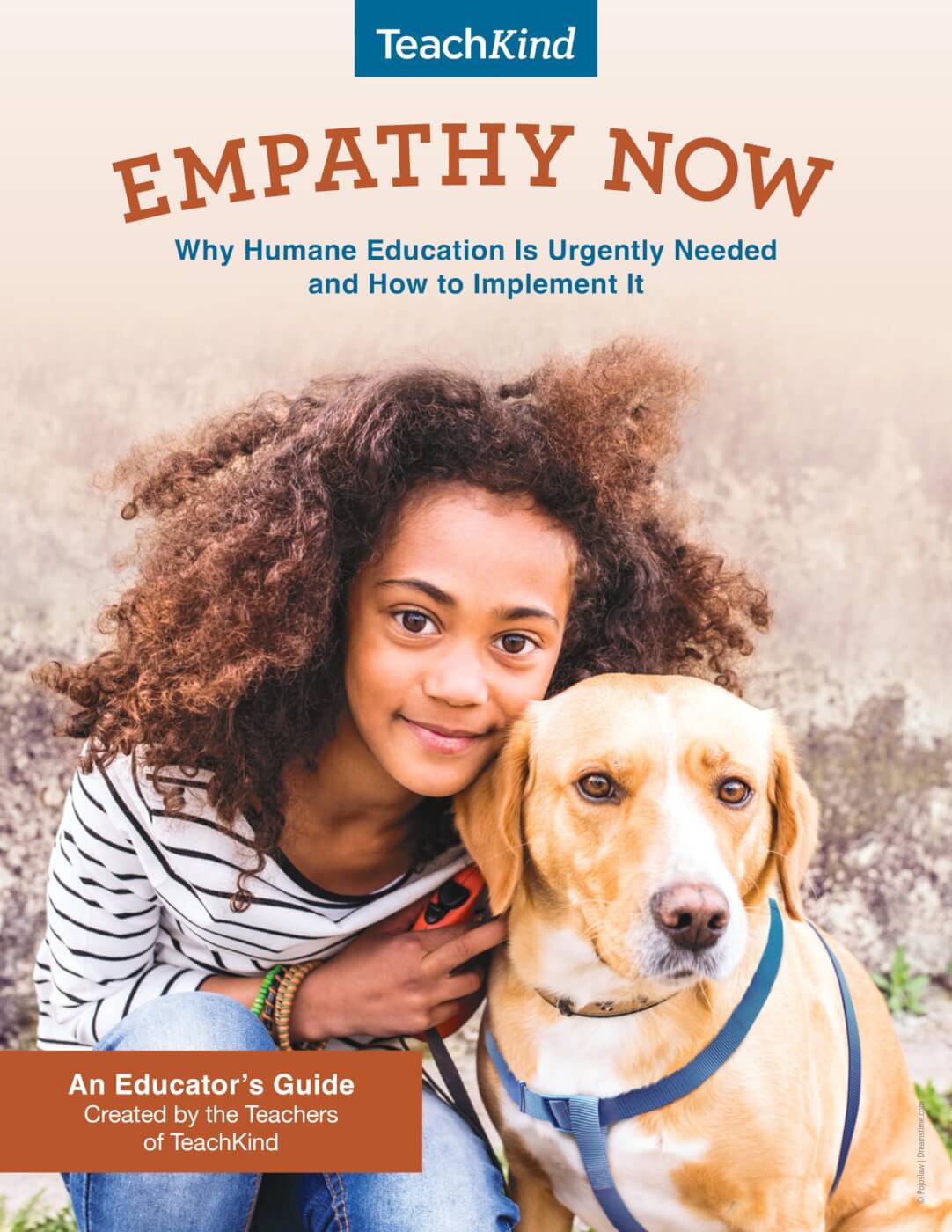What Is Trauma-Informed Education?
Trauma-Informed Education Defined
If you’re an educator, you’ve probably at least heard of trauma-informed education. Simply put, a trauma-informed educator takes into consideration distressing events that students may have experienced in their lifetime, acknowledges that the adverse effects of those experiences may impede the students’ ability to learn, and adjusts teaching practices to help them feel more at ease, thus increasing their chances of learning. Such events can include the divorce of a student’s parents, the death of a loved one, poverty, homelessness, a natural disaster, neglect, abuse, and experiencing or witnessing violence—including violence toward animals.
What Does Trauma-Informed Teaching Look Like?
The trauma-informed educator knows that students who are feeling stress, fear, or anxiety or experiencing other negative side effects of trauma may exhibit a wide range of behavioral issues, from difficulty focusing on tasks to avoiding social interactions to lashing out violently to hurting themselves. While there are a variety of strategies for making your classroom and your curriculum more trauma-informed, teaching compassion for animals can have a host of benefits.
Provide Students With an Outlet
Students who have experienced trauma may be reluctant to tell anyone for a number of reasons, but if you’ve cultivated a safe space in which they are free to express themselves (verbally, in writing, through art, etc.), they may feel comfortable opening up to you. It can be difficult to share details of a traumatic event, especially if talking about other unpleasant topics, such as animal abuse, is altogether avoided in the classroom. Some teachers shy away from discussing sensitive topics because students may become upset. But having hard conversations can not only empower students to help solve real-world problems but also provide them with the vocabulary to tell you their story. Even if students won’t tell you about the abuse that they’ve experienced, they may tell you about the abuse that their family’s animal companion has experienced, providing you with a clue that other acts of violence could be taking place in the home as well.1
Trauma-informed resource: TeachKind’s Rescue Story Reading Comprehension Worksheets

X
Use Students’ Interests to Motivate Them Academically
Students suffering from trauma may have a hard time paying attention in class or may be altogether detached from the activity around them during the school day. Most kids have a soft spot for animals and care about their well-being, though, so incorporating lessons about animals and ways kids can help them can engage even the most reluctant learners. All of TeachKind’s materials are aligned with Common Core Learning Standards and help students practice academic skills, while teaching them about real-world animal issues and the power that they have to make a difference. Many students who have experienced trauma have a strong sense of fairness and detest injustice because they themselves have been wronged in some way. Equipping them with the means to help others can help these students feel in control and empowered.
Trauma-informed resource: Let the Revolution Begin—Student Activism May Be Key to Academic Achievement
Bolster Students’ Social and Emotional Skills
Unfortunately, you can’t change what students have already experienced, and you can’t control their home life. But you can equip them with a set of tools that they can use to overcome adversity and thrive as they get older. Especially now, as we navigate these unprecedented times, children should be encouraged to develop their problem-solving skills, be actively aware of their own well-being, and flex their empathy muscles, including for animals. These foundational skills can boost students’ resilience, help them deal effectively and ethically with life’s challenges, and encourage them to participate in prosocial interactions with their peers so that they’ll contribute to their communities in a positive way for years to come.
Trauma-informed resource: Help Children Develop Social and Emotional Learning Skills With TeachKind Resources

After … the video [about a puppy mill rescue], … a boy raised his hand and started making fun of another student … who was crying during the video. So I just gently said, “That’s OK, because it made me cry. It just shows that you’re compassionate.” And no sooner did I say that [than] about five, six other hands go up to say they were crying during the video as well. And when I reflected on that, I realized that these children who have hard lives at home … don’t always have a safe place to show their emotions. So what we did in that moment was create a safe space for them to be able to show that they care.
—Lisbet Chiriboga
Help Students Strengthen Their Empathy Muscles
You may not be able to erase the trauma that your current students have experienced, but you do have the power to help prevent future generations of both humans and other animals from experiencing abuse and neglect by teaching this generation the importance of empathy. Like our muscles, empathy must be exercised regularly in order for it to grow strong, and students who are taught to be kind to animals and to consider their wants and needs tend to be more empathetic toward their peers. Teaching the easy-to-understand concept of the Golden Rule is a simple, straightforward, effective, and trauma-informed approach to instilling this core value in your students.
Trauma-informed resources: “Share the World” (for grades K–5) and 39 Images and Daily Writing Prompts That Will Help Your Students Develop Empathy for Animals (for grades 6–12)
Animal Abuse as a Form of Childhood Trauma
Cruelty to animals is often overlooked as a form of trauma in young people, but a growing body of research shows that committing violent acts against animals can have traumatic effects on children and teens and that—perhaps even more alarming—simply witnessing violence toward animals can have negative consequences as well.
While many trauma-informed educators are aware that serial killers2 and school shooters3,4 tend to have a history of cruelty to animals, they must also recognize that it is common for young people to have witnessed animal abuse,5,6,7,8 that seeing such abuse is a form of trauma,9 and that children who have observed acts of cruelty to animals are more likely to abuse animals.10,11,12,13 The most egregious cases of cruelty to animals make headlines, but many children encounter animal abuse that goes unreported. This is why it’s urgent that schools implement preventive, trauma-informed measures, such as incorporating humane education, for all students.
It is a moral imperative that teachers identify and actively support students who have witnessed animal abuse—for the safety of both the animal and the child. According to Dr. Barbara Boat, director of the Program on Childhood Trauma and Maltreatment at the University of Cincinnati and executive director of the Childhood Trust at Cincinnati Children’s Hospital Medical Center, “up to 76% of animal abuse occurs in front of children”14 and “the environment in which animal abuse is prevalent can be highly stressful to a child who was never the target of a parent’s aggression.” This stress can have enormous consequences on a child’s cognitive development and their ability to learn:
[D]ata on brain development in young children who are chronically exposed to domestic violence support that a state of heightened arousal (cortisol flooding) results in smaller brains and loss of up to 8 IQ points.15 A brain in constant alarm mode cannot take in or retrieve information efficiently. School performance suffers as do sleep, social skills and emotional and physical health.16 The child’s brain health is compromised.17
Animal Abuse and Child Abuse
Because educators are legally obligated to report suspected child abuse, it’s important to be on the lookout for any indicators—and animal abuse is certainly one. Because domestic abuse is directed toward the powerless, animal abuse and child abuse often go hand in hand. While animal abuse is an important sign of possible child abuse, the parent or other adult isn’t always the one harming the animal. Children who abuse animals may be repeating a lesson learned at home—reacting to anger or frustration with violence, as they’ve seen adults do. Their violence is directed at the only individual in the family more vulnerable than themselves: an animal. Children may also see a sibling or friend abusing an animal. Indeed, animal abuse frequently occurs at the same time and in the same place as other types of violence, particularly family violence.
Animal abuse as it occurs in families and communities often is overlooked as a form of trauma. Because of its strong association with other forms of family and community violence, understanding the occurrence and effect of animal abuse can lead to earlier and more effective identification of children and families at risk and improve the interventions they receive.17
—Trauma, Violence, & Abuse, 2019
Since TeachKind sees reports of cruelty to animals perpetrated by young people across the U.S. on a regular basis, we have created “Empathy Now,” a step-by-step guide that assists schools in addressing these incidents within their communities and in implementing humane education to help prevent future tragedies. This trauma-informed tool can guide your school district’s response to an incident of cruelty to animals, as well as helping you proactively implement humane education across the board.
Empathy Now: Why Humane Education Is Urgently Needed and How to Implement It
Teaching virtually? These trauma-informed practices can be integrated into your distance-learning curriculum:
References
1Boat, B.W., Loar, L. & Phillips, A. (2008). Collaborating to assess, intervene, and prosecute animal abuse: A continuum of protection for children and animals. In F.R. Ascione (Ed.). International handbook of animal abuse and cruelty: Theory, research, and application (pp. 392-422). West Lafayette, IN: Purdue University Press.
2Wright, J., & Hensley, C. (2003). From animal cruelty to serial murder: Applying the graduation hypothesis. International Journal of Offender Therapy and Comparative Criminology, 47(1), 72–88.
3Verlinden, S., Hersen, M., & Thomas, J. (2000). Risk factors in school shootings. Clinical Psychology Review, 20(1), 3–56.
4Arluke, A., & Madfis, E. (2014). Animal abuse as a warning sign of school massacres: A critique and refinement. Homicide Studies, 18(1), 7–22.
5Thompson, K.L., & Gullone, E. (2006). An investigation into the association between the witnessing of animal abuse and adolescents’ behavior toward animals. Society & Animals, 14(3), 221–243.
6Baldry, A.C. (2003). Animal abuse and exposure to interparental violence in Italian youth. Journal of Interpersonal Violence, 18(3), 258–281.
7Gullone, E., & Robertson, N. (2008). The relationship between bullying and animal abuse behaviors in adolescents: The importance of witnessing animal abuse. Journal of Applied Developmental Psychology, 29(5), 371–379.
8Henry, B.C. (2004). The relationship between animal cruelty, delinquency, and attitudes toward the treatment of animals. Society & Animals, 12(3), 185–207.
9Randour, M.L., Smith-Blackmore, M., Blaney, N., DeSousa, D., & Guyony, A.A. (2019). Animal abuse as a type of trauma: Lessons for human and animal service professionals. Trauma, Violence, & Abuse, 1–12.
10Thompson & Gullone.
11Hensley, C., Tallichet, S.E., & Dutkiewicz, E.L. (2009). Recurrent childhood animal cruelty: Is there a relationship to adult recurrent interpersonal violence? Criminal Justice Review, 34(2), 248–257.
12Baldry.
13DeGue, S., & DiLillo, D. (2009). Is animal cruelty a “red flag” for family violence? Investigating co-occurring violence toward children, partners, and pets. Journal of Interpersonal Violence, 24(6), 1036–1056.
14Faver, C.A., & Strand, E.B. (2003). To leave or to stay? Battered women’s concern for vulnerable pets, Journal of Interpersonal Violence, 18, 1367–1374.
15Koenen, K.C., Moffitt, T.E., Caspi, A., Taylor, A., & Purcell, S. (2003). Domestic violence is associated with environmental suppression of IQ in young children. Development and Psychopathology, 15(2): 297–302. Retrieved from http://www.nctsnet.org/nctsn_assets/Articles/122.pdf.
16De Bellis, M.D., Keshavan, M.S., Clark, D.B., Casey, B.J., Giedd, J.N., Boring, A.M., Frustaci, K., & Ryan, N.D. (1999). Developmental traumatology. Part II: brain development, Journal of Biological Psychiatry, 45(10): 1271–1282. Retrieved from https://pubmed.ncbi.nlm.nih.gov/10349033/.
17Boat, B.W. (n.d.). Connections among adverse childhood experiences, exposure to animal cuelty and toxic stress: what do professionals need to consider? National Center for Prosecution of Child Abuse: Update, 24(4), 1–3. Retrieved from http://nationallinkcoalition.org/wp-content/uploads/2014/12/Barbara-Boat-CTA-as-ACEs-toxic-stress.pdf.
18Randour et al.









